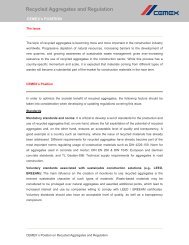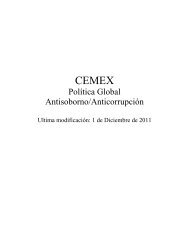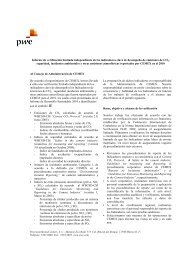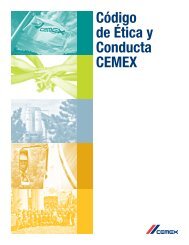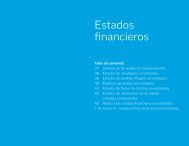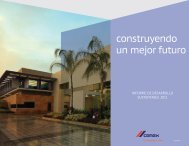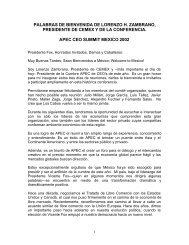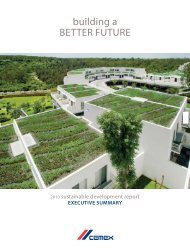building a STRONGER foundation - Cemex
building a STRONGER foundation - Cemex
building a STRONGER foundation - Cemex
You also want an ePaper? Increase the reach of your titles
YUMPU automatically turns print PDFs into web optimized ePapers that Google loves.
Valuation reserves on accounts receivable and inventories<br />
On a periodic basis, we analyze the recoverability of our accounts receivable and our inventories (supplies, raw materials, workin-process<br />
and finished goods), in order to determine if due to credit risk or other factors in the case of our receivables and due to<br />
weather or other conditions in the case of our inventories, some receivables may not be recovered or certain materials in our<br />
inventories may not be utilizable in the production process or for sale purposes. If we determine such a situation exists, book values<br />
related to the non-recoverable assets are adjusted and charged to the statement of operations through an increase in the doubtful<br />
accounts reserve or the inventory obsolescence reserve, as appropriate. These determinations require substantial management<br />
judgment and are highly complex when considering the various countries in which we have operations, each having its own economic<br />
circumstances that require continuous monitoring, and our numerous plants, deposits, warehouses and quarries. As a result, final<br />
losses from doubtful accounts or inventory obsolescence could differ from our estimated reserves.<br />
Asset retirement obligations<br />
We recognize unavoidable obligations, legal or constructive, to restore operating sites upon retirement of tangible long-lived<br />
assets at the end of their useful lives. These obligations represent the net present value of estimated future cash flows to be incurred in<br />
the restoration process, and are initially recognized against the related assets’ book value. The additional asset is depreciated during its<br />
remaining useful life. The increase of the liability, by the passage of time, is charged to the statement of operations of the period.<br />
Adjustments to the obligation for changes in the estimated cash flows or the estimated disbursement period are made against fixed<br />
assets, and depreciation is modified prospectively.<br />
Asset retirement obligations are related mainly to future costs of demolition, cleaning and reforestation, so that at the end of<br />
their operation, raw material extraction sites, maritime terminals and other production sites are left in acceptable condition. Significant<br />
judgment is required in assessing the estimated cash outflows that will be disbursed upon retirement of the related assets. See notes 13<br />
and 20 to our consolidated financial statements included elsewhere in this annual report.<br />
Transactions in our own stock<br />
From time to time we have entered into various transactions involving our own stock. These transactions have been designed to<br />
achieve various financial goals but were primarily executed to give us a means of satisfying future transactions that may require us to<br />
deliver significant numbers of shares of our own stock. These transactions are described in detail in the notes to our consolidated<br />
financial statements included elsewhere in this annual report. We have viewed these transactions as hedges against future exposure<br />
even though they do not meet the definition of hedges under accounting principles. There is significant judgment necessary to properly<br />
account for these transactions, as the obligations underlying the related transactions are required to be reflected at market value, with<br />
the changes in such value reflected in our statement of operations. These transactions raise the possibility that we could be required to<br />
reflect losses on the transactions in our own shares without having a converse reflection of gains on the transactions under which we<br />
would deliver such shares to others. See notes 16, 16A and 16B to our consolidated financial statements included elsewhere in this<br />
annual report.<br />
Emission rights<br />
In some countries where we operate, such as member countries of the European Union (“EU”), governments have established<br />
mechanisms aimed to reduce carbon-dioxide emissions (“CO2”), by means of which industries releasing CO2 must submit to the<br />
environmental authority at the end of a compliance period, emission rights for a volume equivalent to the tons of CO2 released. In<br />
addition, the United Nations Framework Convention on Climate Change (“UNFCCC”) grants Certified Emission Reductions<br />
(“CERs”) to qualified CO2 emission reduction projects. CERs may be used in specified proportions to settle emission rights<br />
obligations in the EU. We actively participate in the development of projects aimed to reduce CO2 emissions. Some of these projects<br />
have been awarded with CERs.<br />
In the absence of a specific MFRS or an IFRS that defines the accounting treatment for these schemes, we account for the<br />
effects associated with CO2 emission reduction mechanisms as follows:<br />
Emission rights granted by governments are not recognized in the balance sheet considering their cost is zero;<br />
Revenues from the sale of any surplus of emission rights are recognized, decreasing cost of sales; in the case of forward sale<br />
transactions, revenues are recognized upon physical delivery of the emission certificates;<br />
Emission rights and/or CERs acquired to hedge current CO2 emissions are recognized as intangible assets at cost, and are further<br />
amortized to cost of sales during the compliance period; in the case of forward purchases, assets are recognized upon physical<br />
reception of the emission certificates;<br />
We accrue a provision against cost of sales when the estimated annual emissions of CO2 are expected to exceed the number of<br />
emission rights, net of any benefit obtained through swap transactions of emission rights for CERs;<br />
83



